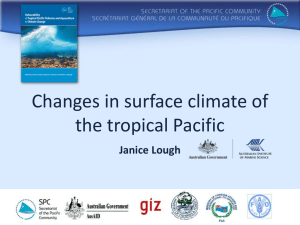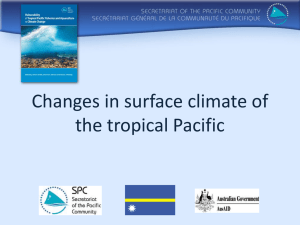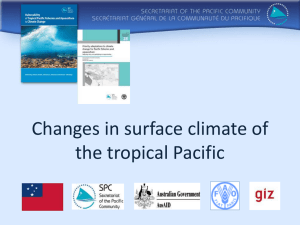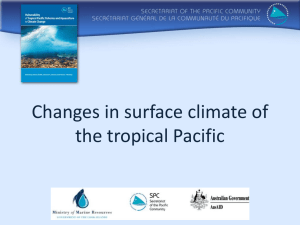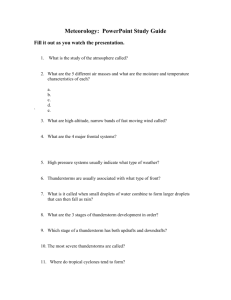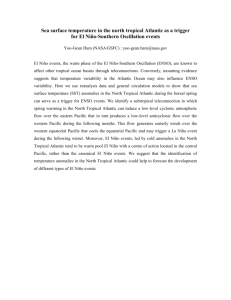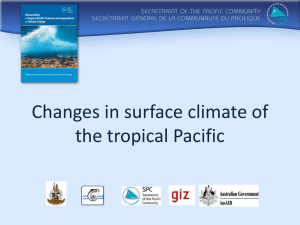Changes in surface climate of the tropical Pacific Presented by Janice Lough
advertisement
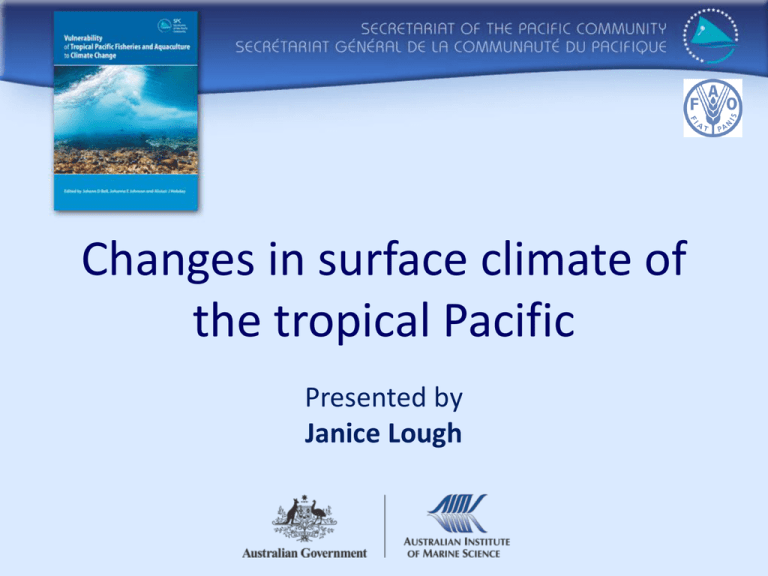
Changes in surface climate of the tropical Pacific Presented by Janice Lough Authors This presentation is based on Chapter 2 ‘Observed and projected changes in surface climate of the tropical Pacific’ in the book Vulnerability of Tropical Pacific Fisheries and Aquaculture to Climate Change, edited by JD Bell, JE Johnson and AJ Hobday and published by SPC in 2011. The authors of Chapter 2 are: Janice Lough, Gerry Meehl and Jim Salinger History of human influence on climate: 1896 “A simple calculation shows that the temperature in the arctic regions would rise about 8o to 9oC, if the carbonic acid increased to 2.5 or 3 times its present value” S. Arrhenius Philosophical Magazine and Journal of Science 1896 (1903 Nobel Prize winner) CO2 290 ppm 0.7oC cooler20cm lower sea level0.1 higher ocean pH75% fewer people Key messages • • • • • • • We are all used to current climate and seasons Humans affecting climate system Climate is already changing Models imperfect but provide possible futures Future will be warmer Some places will be wetter and some drier Extreme weather likely to be more extreme Our climate will be changing for foreseeable future Redistributing sun’s energy = climate system Global annual mean energy budget W m-2 NASA Trenberth et al. (2009) BAMS • Without the atmosphere, the Earth would be ~30oC cooler • More greenhouse gases trap more energy the climate system Pacific atmospheric circulation • Heat engine • Ocean dominates island climates • Trade winds • Convergence zones • Walker & Hadley circulations Sea surface temperature climate Seasonal cycles: wind, rainfall, temperature Winds Rain Temperature Cyclones: destructive weather events www.ncdc.noaa.gov/oa/ibtracs TC Jasmine Feb 12 2012 NASA MODIS www.niwa.co.nz El Niño-Southern Oscillation (ENSO) McPhaden (2004)BAMS • Major source of year-year climate variations • Centred in tropical Pacific • Evolves over 12-18 months • Seasonal forecasts El Niño and La Niña SST anomalies Warmer (red) or cooler (blue) El Niño and La Niña rainfall anomalies Wetter (green) or drier (orange) ENSO shifts SPCZ and tropical cyclones El Niño • Further north El Niño • Further south La Niña La Niña • Fewer cyclones further east El Niño • More cyclones further west La Niña www.niwa.co.nz Climate also varies on decadal timescales c 3 PDO index 2 1 0 -1 -2 -3 1871 1891 1911 1931 1951 Year 1971 1991 jisao.washington.edu/pdo • Pacific Decadal Oscillation (PDO) • Cooler: SPCZ displaced SW & ENSO variability stronger • Warmer: SPCZ displaced NE & ENSO variability weaker Results in average seasonal climate • What we expect = climate • Includes variability (range) • What we get = weather Why are climate scientists so sure climate is changing due to human activities? • Theory • Modelling • Evidence: instrumental measurements changes in the physical world changes in the biological world paleoclimate archives The climate system appears to be changing faster than earlier thought likely (Steffen 2009) Measured increase in carbon dioxide 18th century = 280ppm air bubbles in ice cores Observed warming of global temperatures Observed warming of tropical oceans Projecting future climates (2100) Scenario IPCC-AR4 (2007) Low emissions (B1) High emissions (A2) Temperature (oC) CO2 (ppm) +1.8 (1.1-2.9) +3.4 (2.0-5.4) 450-500 750-800 • Good observations • Understanding of climate system • Realistic models • Predict future forcing – how much more greenhouse gases? • “Downscaling” to scales that matter to us Range of possible futures Projected surface temperature warming • Averages from several models • Spatial difference in magnitude • Future will be WARMER IPCC AR4 2007 Projected rainfall changes • Wetter convergence zones • Drier subtropics • More extreme wet years • More intense droughts IPCC AR4 2007 Extremes The answer to the oft-asked question of whether an event is caused by climate change is that it is the wrong question All weather events are affected by climate change because the environment in which they occur is warmer and moister than it used to be Trenberth (2012)Climatic Change Preparing for TC Jasmine Vanuatu Photo: Mohammed Ashiq Photo: VBTC Possible new climates Temperature (oC) Now 2035 2050 2100 28.2 28.0 25.6 23.9 20.9 28.9 28.7 26.3 24.6 21.6 29.9 29.4 27.0 25.3 22.1 31.4 30.9 28.5 26.6 22.8 Rainfall (mm) Now 2035 2025 2100 Tarawa Funafuti Nadi Raratonga Pitcairn 725 1,160 785 425 380 780 800 1,250 835 1,340 900 490 320 Tarawa Funafuti Nadi Raratonga Pitcairn 460 350 Summary •Future will be warmer •Some islands wetter and some drier •Maybe fewer but stronger tropical cyclones •More frequent and stronger extreme weather events •Unclear how ENSO will change – continued influence •Importance of RATE of change •Not just a “new climate” to which we can adapt For foreseeable future climate will be CHANGING
